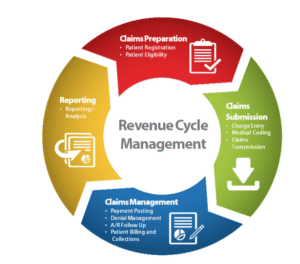The financial health of any healthcare practice hinges on a well-managed revenue cycle. This isn’t just about sending out bills; it’s a comprehensive process that begins long before a patient even sees a doctor and ends only when the final payment is collected and accounted for.
A complete and efficient revenue cycle management (RCM) system is the backbone of a financially stable practice, ensuring that every service rendered is properly compensated. Understanding each stage of this cycle is crucial for optimizing operations, minimizing errors, and maximizing revenue.

The journey begins at the very first point of contact with the patient: Patient Registration. This seemingly simple step is, in fact, the most critical foundation of the entire revenue cycle. It involves gathering accurate demographic and insurance information, which is essential for proper billing.
Errors here a misspelled name, an incorrect policy number, or an outdated address can cause a domino effect of issues down the line, leading to claim denials and payment delays. Best practices at this stage include verifying insurance eligibility and benefits in real-time, which helps to determine the patient’s financial responsibility upfront, like copayments or deductibles.
Next is Charge Capture, the process of accurately documenting all services provided to the patient during their visit. This involves translating medical services into billable codes, using standardized systems like CPT codes for procedures and ICD-10 codes for diagnoses.
An efficient charge capture process ensures that every service, from a simple consultation to a complex surgical procedure, is accounted for. Any missed charges or incorrect codes can result in lost revenue or claim rejections, making this stage a key focus for an effective revenue cycle.
Following charge capture is Claim Submission. Once all services are coded, a clean claim is prepared and sent to the patient’s insurance company. A “clean claim” is one that is free of errors and contains all the necessary information for the payer to process it. Submitting claims electronically via an Electronic Data Interchange (EDI) system is the industry standard, as it is faster and more reliable than paper-based submissions. This stage also includes ensuring that the claim adheres to all payer-specific rules and regulations, as a single missing piece of information can lead to a denial.
The Adjudication and Denial Management phase is where the claim is reviewed by the insurance payer. The payer determines how much they will reimburse based on the patient’s policy and the services provided. Often, claims are denied or rejected for various reasons, such as coding errors, lack of medical necessity, or issues with patient eligibility. This is a high-impact stage of the revenue cycle. Proactive denial management involves identifying the root cause of the denial, correcting the error, and resubmitting the claim promptly. A strong denial management process is vital for recovering revenue that might otherwise be lost.
Once a claim is adjudicated, the insurance company sends an Explanation of Benefits (EOB) to the provider and a remittance advice, outlining the payment amount and any patient responsibility. The practice then moves to Payment Posting, where the payment and the details from the EOB are meticulously entered into the patient’s account in the practice’s billing system. This stage reconciles the payment received against the billed amount and updates the patient’s remaining balance.
The final stage is Patient Statement and Follow-up. After the insurance has paid its portion, the patient is responsible for any remaining balance, such as copays, deductibles, or non-covered services. A clear and accurate patient statement is generated and sent out. The practice then follows up on outstanding balances through calls, automated reminders, and payment plans. Effective patient follow-up is crucial for the final collection of revenue and a complete revenue cycle.
Each step of the revenue cycle is interconnected. An error at the beginning (e.g., in patient registration) can ripple through the entire process, leading to delays and lost revenue. By focusing on accuracy and efficiency at every stage, from the initial appointment to the final payment, a healthcare practice can significantly improve its financial performance and focus on its primary mission: providing excellent patient care.
5 FAQs About the Complete Revenue Cycle
Q1: What is the difference between “clean claims” and “denials”?
A1: A clean claim is a billing claim submitted to an insurance company that has no errors and is processed for payment on the first submission. A denied claim, on the other hand, is a claim that the insurance company refuses to pay due to an error, such as incorrect coding, missing information, or a service not being medically necessary.
Q2: Why is patient registration considered the most important step in the revenue cycle? A2: Patient registration is the foundation of the entire cycle. If the patient’s demographic or insurance information is incorrect at the start, every subsequent step from eligibility verification to claim submission and payment will be compromised. This can lead to delays, denials, and significant administrative work to correct the errors.
Q3: What is the role of a Clearinghouse in the revenue cycle?
A3: A Clearinghouse acts as a middleman between the healthcare provider and the insurance payers. It checks claims for errors before they are sent to the insurance company, ensuring they meet the specific requirements of each payer. This service significantly increases the chance of submitting clean claims and reduces denials.
Q4: How does technology impact the revenue cycle?
A4: Modern technology, such as Practice Management Systems (PMS), Electronic Health Records (EHR), and automated billing software, streamlines the entire revenue cycle. These systems automate tasks, improve data accuracy, and provide valuable analytics to track key performance indicators (KPIs) like days in accounts receivable and denial rates, making the process faster and more efficient.
Q5: What are Accounts Receivable (A/R) and why is monitoring them important?
A5: Accounts Receivable (A/R) refers to the money owed to the practice for services rendered that have not yet been paid. This includes payments from both insurance companies and patients. Monitoring A/R is critical because a high A/R days count indicates a slow collection process, which can negatively impact a practice’s cash flow and financial stability.


